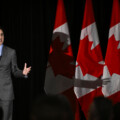Several months ago, the earth shook in Ontario and sent reverberations across the Canadian system of education. The Ontario Human Rights Commission ruled that children had “the right to read” and were being denied it in that province’s schools. Most “learning disabilities” labels were actually the result of reading failures, the latest OHRC inquiry found. And most tellingly, students from disadvantaged communities were the most likely to bear the brunt of ineffective reading instruction in elementary schools.
Thousands of Ontario parents with children struggling to read have now broken the silence. Over the past two years, they came forward, sometimes with their kids, to provide heart-wrenching personal testimonies about how current early reading programs have failed them. On February 28, 2022, that Commission,OHRC Right to Read inquiry calls for critical changes to Ontario’s approach to early reading headed by Chief Commissioner Patricia DeGuire and backed by the latest evidence-based research, simply demolished prevailing methodologies and programs which have left far too many kids unable to read to a level of functional literacy.
An estimated nine out of ten children are capable of learning to read when provided with the proper instruction. That factoid, generated by International Dyslexia Association (IDA Ontario) research, was confirmed by the Ontario Human Rights Commission. The fundamental problem is that one-third of our youngest students, the vast majority enrolled in so-called “balanced literacy” programs, simply cannot read with the fluency needed in today’s world.
Starting in October 2019, the Right to Read inquiry looked at a representative cross-section of eight English language school boards, including Peel District School Board and Hamilton-Wentworth District School Board and all 13 English-language faculties of education and Ministry of Education sanctioned curriculum. In addition to listening to a multitude of concerned parents,Why some parents are eager for changes to Ontario’s early reading curriculum the inquiry tapped into the research expertise of leading learning disabilities researchers, including Linda Seigel of the University of British Columbia and Jamie Metsala of Halifax’s Mount Saint Vincent University.
While Chief Commissioner DeGuire refrained from pointing fingers, it was clear that current early reading methods were not working and the commission got a “mixed response” from education faculties regarding the findings. That’s no surprise because most faculties provide little if any preparation informed by the science of reading and model curricula based upon the “balanced literacy” dogma peddled by the dominant learning resource providers.
When one-out-of-three students graduate without reaching provincial or international standards, someone, somewhere, has to assume responsibility for the outcomes. Vulnerable students—those from impoverished and marginalized communities—were already struggling before the two-year-long pandemic school disruptions. OHRC’s legal counsel Reema Kawaja said it best: “No child should go to school for 14 years and not learn to read.”
Current reading instruction methods are deeply entrenched and their defenders have succeeded, for three decades, in sinking periodic assaults on that hegemony. Generations of elementary teachers have stayed the course, rebranding “whole language,” applying the reading recovery band-aid, and fuzzing up the whole question with “balanced literacy” providing continued cover for those same methods.
This transition has been facilitated and enabled by Canada’s faculties of education where teachers are introduced to literacy programs and inculcated in provincially-sanctioned texts and learning materials, exemplified by Fountas & Pinnell, North America’s largest purveyor of “balanced literacy” learning resources, teacher training, and classroom assessment tools.
New Brunswick Education Minister Dominic Cardy was one of the first off-the-mark in reacting to the Right To Read findings. With news of the earth-shaking February 28 Ontario report breaking, he took to Twitter with another impossible-to-ignore and quotable declaration heard across the K-12 education world.
“Our approach to reading instruction was a disgrace,” Cardy tweeted. “We gave teachers a job and didn’t give them the tools to do it. For me, this is the biggest education scandal of the last fifty years.” Just in case you thought Minister Cardy was simply blowing off steam, he repeated his claim for Brunswick News in much greater detail.
Minister Cardy and his Department were one of the first to wade into the latest iteration of the reading wars. “It’s crazy,” he told Brunswick News. “[There are] two camps. One is based upon reality, and one is not. And for a long time, we followed the one that is not based upon reality.” Like the thousands of Ontario parents, Cardy challenges the prevailing theory that “if you surround [children] with lots of books, they will learn how to read.”
The Right to Read inquiry report may well tip the balance and, it should be noted, Ontario Education Minister Stephen Lecce was quick to endorse the reportOntario to revamp approach to literacy in schools after report calls for change and its 157 recommendations for change The most critical of those is Recommendation 30 which fully embraces systematic reading strategies, including phonics, and rejects the still popular “three-cue” guess-the-word methodology.
What is astounding is that the OHRC actually spelled out in detailhttps://www.ohrc.on.ca/en/right-to-read-inquiry-report/executive-summary the key requirements to successfully teach and support all students:
- “Curriculum and instruction that reflects the scientific research on the best approaches to teach word reading. This includes explicit and systematic instruction in phonemic awareness and phonics, which teaches grapheme to phoneme (letter-sound) relationships and using these to decode and spell words, and word-reading accuracy and fluency. It is critical to adequately prepare and support teachers to deliver this instruction.
- Early screening of all students using common, standardized evidence-based screening assessments twice a year from kindergarten to Grade 2, to identify students at risk for reading difficulties for immediate, early, tiered interventions.
- Reading interventions that are early, evidence-based, fully implemented and closely monitored and available to ALL students who need them, and ongoing interventions for all readers with word reading difficulties.
- Accommodations (and modifications to curriculum expectations) should not be used as a substitute for teaching students to read. Accommodations should always be provided along with evidence-based curriculum and reading interventions. When students need accommodations (for example, assistive technology), they should be timely, consistent, effective and supported in the classroom.
- Professional [Psycho-educational] assessments, should be timely and based on clear, transparent, written criteria that focus on the student’s response to intervention. Criteria and requirements for professional assessments should account for the risk of bias for students who are culturally or linguistically diverse, racialized, who identify as First Nations, Métis or Inuit, or come from less economically privileged backgrounds. Professional assessments should never be required for interventions or accommodations.”
The OHRC inquiry report provides plenty of sound research and detailed policy guidance for Ontario, New Brunswick, and other provinces. By the end of next year, 2022-23, the New Brunswick version will be in place in Kindergarten to Grade 2. It’s already being implemented in a few Ontario pilot schools, including those in the York Region Catholic District School Board, north of Toronto, and the Hamilton Wentworth District School Board was the first to commit to acting on the OHRC recommendations.
Tackling the problem will not be easy because prevailing “balanced literacy” approaches are deeply entrenched in most faculties of education. One of the first to cast a stone was Shelley Stagg Peterson, professor of literacy at OISE/University of Toronto, and, since then, Brock University professor Diane Collier, who represents a group of literacy researchers from nine different education faculties in Ontario.
“Reading English is not phonetical; it is visual,” Stagg Peterson wrote in an Ottawa Citizen Letter to the Editor. “If a child has a good visual memory, he or she will be able to read anything they can understand by the end of grade one.” Then came a couple of astounding statements: “Poor readers can have wonderful careers in many fields. Phonics is a useful tool in learning to read but it is not a method.”
Education faculty literacy professors have rallied in defence of the dominant pedagogy and mandated resources. “There is no one-size-fits-all for reading,” Professor Collier told CBC News. “A highly systematized, step-by-step approach is not necessarily accessible for all students who have all kinds of needs, so it could further marginalize readers.” Their counter-strategy is clear—paint the Right To Read findings as an endorsement of “phonics” and attack it as advocating a “narrow” approach, sidestepping the findings and the ineffectiveness of current methods.
The Ontario Right To Read inquiry report put existing literacy programs on notice but their defenders, ensconced in the education faculties, are not about to yield or give ground when learning resource alliances and training contracts are at stake. Reading reformers now know that it’s going to be a long siege and will require vigilance throughout the implementation process.
Recommended for You

Crystal Smith and Eva Clayton: Indigenous natural resources development is an efficient, fair, and responsible way to advance economic reconciliation

Peter Menzies: Justin Trudeau’s legislative legacy is still haunting the Liberals

‘There are consequences to this legislation’: Michael Geist on why the Canada-U.S. digital services tax dustup was a long time coming

Rudyard Griffiths and Sean Speer: The future of news in Canada: A call for rethinking public subsidies




